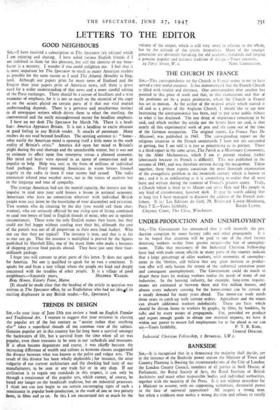TRENDS IN DESIGN
Snt,—In your issue of June 13th you review a book on English Popular and Traditional Art. I venture to suggest that your reviewer in classing the popular art of the last century as "quaint rather than anything else" takes a superficial though all too common view of the subject. Genuine popular art in this country has for long been a-survival amongst the backwaters of life, but a survival from the time when all art was popular, even those treasures to be seen in our cathedrals and museums. If it often became degenerate and coarse, it was chiefly because the increasing difference of wealth and culture as between classes exaggerated the divorce between what was known as the polite and vulgar arts. The result of this divorce has been wholly deplorable ; for instance, the utter vulgarity of our current architecture and the shocking bad taste of our manufacturers, to be seen at any trade fair or in any shop. If our civilisation is to regain any standards in this respect, it can only be through a renaissance of the popular arts, which cannot, of course, be based any longer on the handicraft tradition, but on industrial processes. I think one can just begin to see certain encouraging signs of such a renaissance in popular book-production, in the work of one or two pottery firms, in films and so on. In this I am encouraged not so much by the volume of the output, which is still very small in relation to the whole, but by the attitude of the artists themselves. Many of the younger generation are obviously forsaking the old academic standards and forging a genuine popular and national tradition of design.—Yours sincerely,


































 Previous page
Previous page